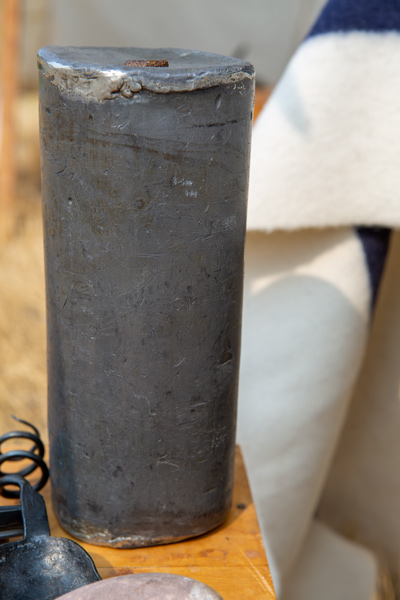Lead Canisters
© 2017 by Kristopher K. Townsend. Permission to use granted under the Creative Commons Attribution-Share Alike 4.0 International license.
In Philadelphia in May 1803, Lewis ordered 52 lead canisters specially made to carry and protect the expedition’s gunpowder. None of the original canisters is known to exist.
At Fort Clatsop on 1 February 1806, Lewis wrote:
Today we opened and examined all our ammunition, which had been secured in leaden cannesters. We found twenty seven of the best rifle powder, 4 of common rifle, three of glaized and one of the musqut powder in good order, perfectly as dry as when first put in the canesters, although the whole of it from various accedents has been for hours under the water. These cannesters contain four lbs of powder each and . . . 8 of lead. Had it not have been for that happy expedient which I devised of securing the powder by means of the lead, we should not have had a single charge of powder at this time. Three of the canesters which had been accedentally bruized and cracked, one which was carelessly stoped, and a fifth that had been penetrated with a nail, were a little dammaged; these we gave to the men to make . . . dry; however exclusive of those five we have an abundant stock to last us back; and we always take care to put a proportion of it in each canoe, to the end that should one canoe or more be lost we should still not be entirely bereft of ammunition, which is now our only hope for subsistence and defence in a rout of 4000 miles through a country exclusively inhabited by savages.
As it turned out, they had more than enough to get them home. Lewis could even afford to give a couple of pounds of powder and some lead to two trappers he met coming up the Missouri River six months later, on 12 August 1806.
In addition to powder and lead, Lewis bought a supply of “fixed ammunition”—prefabricated paper cartridges each containing a lead ball and enough powder to fire it. These were intended for use in the smooth-bore muskets, but they were hard to keep dry; the paper often soaked up moisture and dampened the powder inside.
Experience the Lewis and Clark Trail
The Lewis and Clark Trail Experience—our sister site at lewisandclark.travel—connects the world to people and places on the Lewis and Clark Trail.
Discover More
- The Lewis and Clark Expedition: Day by Day by Gary E. Moulton (University of Nebraska Press, 2018). The story in prose, 14 May 1804–23 September 1806.
- The Lewis and Clark Journals: An American Epic of Discovery (abridged) by Gary E. Moulton (University of Nebraska Press, 2003). Selected journal excerpts, 14 May 1804–23 September 1806.
- The Lewis and Clark Journals. by Gary E. Moulton (University of Nebraska Press, 1983–2001). The complete story in 13 volumes.


